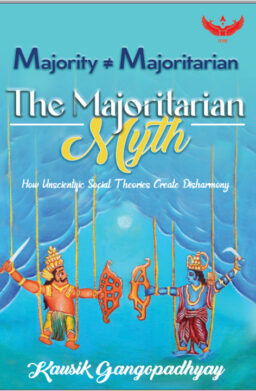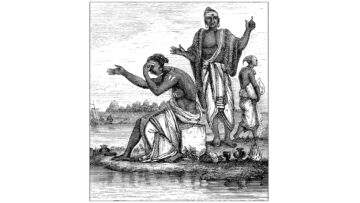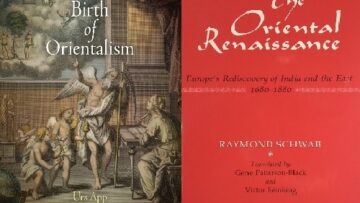Introduction
On one hand, it is easy to describe what this book is about. In a nutshell:
The author of the book, Kausik Gangopadhyay, claims that, in the event of a conflict between two or more communities in a body politic (a nation state, country etc.), a certain section of the Left/Liberal media and intelligentsia always looks at the majority as the oppressor, and the minorities as the victims. He refers to this tendency as the majoritarian myth.
Gangopadhyay especially focuses on how the Left Indian media and intellectuals frame Hindu-Muslim communal violence and his book is an attempt to challenge that narrative. One of the positives about Gangopadhyay’s book is that it is written in a simple and clear language. The other positive is that Gangopadhyay correctly explains with clarity how the so-called majority of India, the Hindus, are disadvantaged by the constitution and legal system, the very same constitution and legal system that is biased in favour of, and provides special privileges to the socalled minorities of India.
Understanding the majority-minority problem in Indian society requires conceptual rigour and systematic research. The concepts of majority, minority and interrelated ideas such as majoritarianism and minorityism has a long history within European political science and philosophy.
If one seeks to genuinely understand the phenomenon, it requires multidisciplinary historical research of the development of these concepts in Europe, and how the British incorporated these concepts into the colonial government they set up in India.
The author does discuss the ideas of some famous European thinkers such as Alexis Tocqueville, John Locke, and Antonio Gramsci. The reader would have benefited from a clearer elaboration of how the ideas of these thinkers help us understand majoritarianism and minorityism.
Kaushik Gangopadhyay tries to come up with an alternative hypothesis to explain the conflict between majority and minority communities viz. Linear Theory of Social Evolution (LTSE). This theory, however, does not help us understand the phenomenon of majority-minority conflict. I will examine the concept of LTSE later in this review.
Description of the Topic
Gangopadhyay uses the terms majoritarianism and the majoritarian myth synonymously. The author defines majoritarianism as an idea that claims that in the event of a conflict between a majority and minority population, the majority is always the oppressor, and the minority is always the oppressed. Kausik Gangopadhyay’s alternate hypothesis is that in the event of conflict between two communities, it is not the numerical strength or lack of strength of a community that is the determinant of its oppressor-victim status, but whether or not the community believes in what the author describes as the Linear Theory of Social Evolution (LTSE).
While the knee jerk tendency to automatically paint the numerical majority as the oppressor (by certain sections of the media and the intellectual class) is a real phenomenon, it is inaccurate to call it majoritarianism. In encyclopaedias and political science textbooks, majoritarianism is defined as an ideology that a majority based on religion, language, nationality or other category of population is entitled to a degree of primacy in society.
But that is a minor quibble. The author does a good job of criticizing the majoritarian myth in the Indian context. He discusses in detail the articles of the constitution such as Article 24 and 28, and makes it clear that the constitution not only privileges the minorities of India, but is explicitly anti-Hindu.
The book could have been even better if it had critically examined the very categories of majority and minority themselves, and whether or not it applied in the Indian context. The minority is defined in some of the legal documents in the West as a group of people who are numerically inferior to the rest of the population in a state, and is in a non-dominant position, and having a collective will to survive and achieve equality. In contrast, the majority is a group of people who are numerically dominant in a state, and have the position of relative agency and power. It is important to keep in mind that the categories of minority and majority are contextual and relational. For example, the Muslim population of India are commonly referred to as the minority. But if Muslims are the minority, who are the majority? If one replies Hindus, then we come to the question of what is Hinduism, and what makes somebody a Hindu?
The author rightly recognizes that the term ‘Hinduism’ is a recent invention that doesn’t precede the nineteenth century and refers to any and all traditions that are not Muslim, Christian, Buddhist or Sikh. The same considerations apply to the category of ‘Hindu’ which is anybody who doesn’t fall into any of the other categories mentioned above. If we drop the term ‘Hindu’ and divide the Hindu population by jatis and sampradayas, then Muslims are not the minority. The reader would have been better served if the above points had been brought out prominently.
And then there is the question of how the notion of dividing the population of an area into majority and minority populations developed in the West. This way of thinking about communities, with each of them (the minority and majority) exercising their collective will, is alien to India. What happens when these concepts, and the legal and political systems based on these concepts, migrate here?
These are important questions that the book does not address. Hopefully, these are addressed more thoroughly in future works.
Tocqueville, Locke, and Gramsci
Gangopadhyay dedicates two chapters of this book to the origins of the majoritarian myth in which he discusses Tocqueville, John Locke, and Gramsci in some detail. As mentioned, even though the author summarizes the ideas of Tocqueville and Locke regarding majorities and minorities, the book does not explain explicitly how such ideas contributed to the development of the majoritarian myth. More than Tocqueville or Locke, the author attributes the development of the majoritarian myth to the ideas of the philosopher Antonio Gramsci. The claim is that Gramsci was a ‘cultural Marxist’ whose theory is based on the primacy of culture in shaping the relations between the classes. In this relationship, the culture of the majority becomes an oppressive force against the minority. However, in Gramsci’s theory of cultural hegemony, the state and the capitalist class use cultural institutions to maintain power in capitalist societies. His theory of cultural hegemony is not about the culture of the majority oppressing the minority.
Linear Theory of Social Evolution
Kausik Gangopadhyay claims that in the event of a conflict between two communities, regardless of which community is the majority and the minority, the community which believes in a Linear Theory of Social evolution will be the source of social intolerance and oppression. The first question that comes to my mind when I read this claim: What is an LTSE? According to Gangopadhyay, it is the belief in a linear social plan, which the believers are supposed to carry out forever. The believers in the LTSE are supposed to discriminate against those who are non-believers. The three primary examples of LTSE that Gangopadhyay brings up are Christianity, Islam, and Marxism. Christian and Muslims do indeed believe that history is governed by God’s plan, and they have a role in this plan. It is also true that one of the mechanisms through which Christianity and Islam spread is proselytization. But what is meant by ‘social evolution’? The term is left to the reader to interpret. An elaboration in the book would have been beneficial.
Marxism is an interesting case. Marx did try to identify patterns and make predictions about how human societies would develop, based on the relation between the classes. But he didn’t think of human history as a plan. In order to believe that human history is a plan, one has to believe in a planner, in other words, God. God has no role to play in the Marxist view of human history.
As mentioned, Kausik Gangopadhyay states that communities that believe in an LTSE will be the source of social intolerance and oppression, when there is conflict between communities. The author is partially right here, since the mechanism by which Christianity and Islam spread, namely proselytization, brings it into conflict with pagan communities, whether it be pagan Rome or India. It is especially clear that conversion activities are a source of social intolerance and oppression when non-believers are forcibly converted through physical violence and threats. However, in other situations of conflict, it is unclear which party is the source of conflict. For example, in the Sri Lankan civil war, either the Tamil Tigers or the Sinhalese government could be held as the source of conflict depending on one’s point of view. The Sinhalese government used their legal system to discriminate against Tamils. But it can also be argued that the Tamil Tigers are the source of the conflict because they are the ones who instigated a military conflict with the Sri Lankan government.
Kausik Gangopadhyay states that one of the ways to test the hypothesis of LTSE is to observe which community experiences a reduction in population. In the event of a conflict between two communities, the community which experiences a reduction in population is the oppressed community, while the other community is the oppressor. Such a test is liable to produce inaccurate results: there are many factors that play a role in the reduction of the population of a community, even when it is in conflict with another community.
Final Thoughts
Overall, Kaushik Gangopadhyay does a good job in poking holes in the notion that India’s Hindu population is a dominant majority, using articles of the constitution to show that India’s so called majority population is being discriminated against by the political and legal system.
The applicability of Linear Theory of Social Evolution in understanding the issue of minority-majority conflicts in India has to be examined more critically.
Disclaimer: The opinions expressed in this article belong to the author. Indic Today is neither responsible nor liable for the accuracy, completeness, suitability, or validity of any information in the article.











